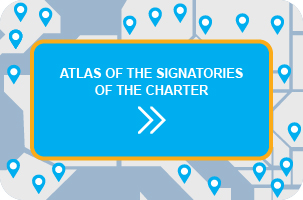The Charter in brief
How was the European Charter for Equality of Women and Men in Local Life born?
In 2004, the European Commission supported an ambitious project initiated by the Council of European Municipalities and Regions (CEMR): the elaboration of a portrait of a virtual town in which gender equality is fully achieved.
By identifying examples of various methods put in place, CEMR provided a concrete tool for local and regional authorities on how they could work with equality. The result of the project was the publishing of the brochure the Town for Equality gathering examples of good practices from around one hundred European cities and communities in eleven of their fields of expertise.
During the project, it became clear, that there was a lack of expertise and of instruments enabling the setting up of global gender equality policies at local and regional level.
Once the Town for Equality was virtually established, CEMR wished to encourage local and regional governments to take a further step in making this reality by making a political commitment. This is how the idea of establishing the European Charter for Equality of Women and Men in Local Life was born.
The Charter was launched in 2006 within the framework of a project (2005-2006) supported by the European Commission, through its 5th Community Action Programme for equality between men and women.
In 2022, CEMR and its member associations undertook the task of updating the Charter text to ensure its continued utility and relevance for Europe’s towns and regions. The amended and expanded text was adopted by CEMR’s Policy Committee on 6 December 2022.
Find out about the update and what it means for existing and future Charter signatories HERE.
What is the Charter?
The Charter was drawn up by CEMR in collaboration with the project partners and its national associations. The outcome of the Charter reconciles different visions of equality in Europe and compiles a summary of the proposals of all the contributors (hundreds of local and regional representatives). Moreover, the Charter takes into account the different competences of local and regional authorities in Europe.
By signing the Charter, local and regional actors make a strong and formal public commitment to the principle of equality and are encouraged to implement policies and concrete actions in cooperation with institutions and organisations in their territories.
The Charter is a public instrument laying down rights, but it is not binding. CEMR is aware that it is very demanding work to reach all the objectives outlined in the Charter, that’s why, CEMR recommends signatories to implement the Charter progressively and identify priority fields for intervention.















